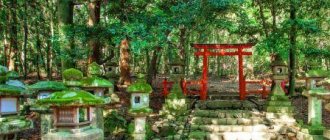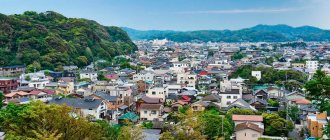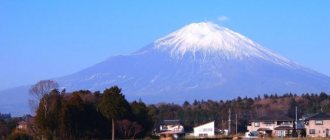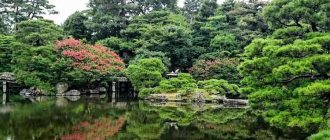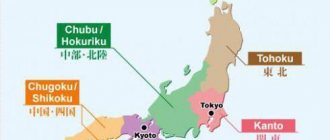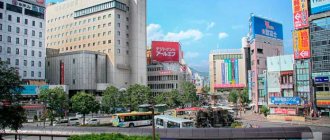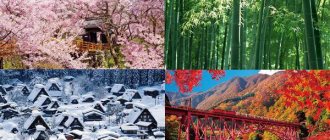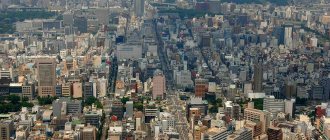Capitals of Japan. Nagaoka-Kyo (784-794)
Nagaoka-Kyo was founded as the capital of Japan in 784 after Emperor Kanmu transferred the State Council to Heijo (today Nara). The reason for the Emperor's preference for Nagaoka-Kyo was the presence of rivers, which provided excellent water transport. However, these rivers were the cause of the city's downfall, as frequent floods and constant dampness led to various diseases among the inhabitants, which eventually forced the emperor to move the capital to Heian-Kyo in 794.
Kyoto. Ancient capital and cultural center of Japan
I continue to publish reports from my trip to Japan. This post will be about the ancient capital and cultural center of the country - Kyoto.
We got to Kyoto on a super express - the Hikari Shinkansen No. 503, which was the subject of the last post. The journey from Odawara to the ancient capital takes about 2 hours. Time on the road flies by unnoticed - the stunning landscapes outside the window do not let you get bored.
Kyoto Station. The main transport hub of the city. All modes of transport available in Kyoto converge here.
1.
Upon arrival, we were treated to a tour of Kyoto. The first thing that caught my eye was the very low building - 2-3 floors; according to Buddhist traditions, houses should be no higher than 30-39 m, since no one should reach the Buddha. That's why Kyoto looks very cozy. But there are also high-rise buildings, of course, but without skyscrapers.
Golden Pavilion (Kinkakuji) The main postcard view of Kyoto. The most visited place by tourists. 2.
The pavilion building is indeed covered, with the exception of the first floor, with sheets of pure gold. During the last restoration they were replaced with thicker ones. The top of the gold is coated with a special varnish. 3.
4.
5.
The temple is located on an island in the middle of the Mirror Lake Kyokochi. The Golden Pavilion is a symbol of Kyoto and continues to serve as an object of worship. On the territory, for a small fee, you can order a tea ceremony, in the same house where the emperor once drank tea.
6.
7.
The garden on the grounds of the Ryoan-ji Buddhist Temple - the Temple of the Rest of the Dragon is included in the UNESCO World Heritage List. 8.
9.
Rock Garden (Ryoanji)
The garden is designed in the form of a small rectangular area, fenced with a clay fence on three sides. The entire area is covered with white gravel, and on it there are 15 stones, organized in five groups. The gravel itself is raked into thin stripes, creating the feeling of soft water ripples. The Ryoanji rock garden is part of the temple structure, so you can only get to it through the temple premises, having first taken off your shoes, and you can enjoy this splendor while sitting on the veranda.
Everyone who contemplates this beauty has their own associations. For some, these are five mountain peaks soaring into the clouds, for others - islands in the endless expanses of the ocean... In general, everything depends on the purity and depth of the inner world. The main mystery of this creation is that no matter from which side you look at the garden, you can see only 14 stones, and one of them will always disappear from view. But there is one single point from which all 15 are visible, but they don’t talk about it, why ruin such a wonderful legend.
10.
11.
Nijo Castle The architecture of the complex is remarkable - it has two rings of fortifications, each of which consists of an impressive wall and a wide moat filled with water. There were powerful gates leading into each wall—three to the outer wall and another pair of gates to the inner one.
12.
13.
The main buildings on the territory of the citadel are Honmaru Castle and Gardens (in the inner ring) and Ninomaru Castle, which is located between two rings of fortifications.
14.
Ninomaru Palace is the pearl of Nijo, it was here that the shogun lived and worked, received his vassals and messengers. The palace's 33 luxurious rooms include more than 800 tatami (tatami is a mat covering the floor; in Japan, the area of a house is counted not by square meters, but by the number of tatami). All the halls were designed for specific needs, as clearly evidenced by the amazingly beautiful wall paintings. Herons, flowers and tigers and leopards, unprecedented for Japan, are for meetings and negotiations. Gray and black and white landscapes with sleeping sparrows are for living quarters. In total - more than 3 thousand paintings. Photography inside the castle is prohibited.
Another “trick” of Ninomaru is all sorts of medieval tricks, these are creaky “nightingale floors” that foreshadow the approach of the enemy, and security rooms, surprisingly invisible behind paper walls, and secret doors that allow you to instantly leave the building.
15.
After visiting the castle, it’s worth taking a walk through the picturesque Ninomaru Garden, where there is a small pond with three islands, which can be considered a masterpiece of landscape design.
16.
17.
Kiyomizudera (Pure Water Temple) is one of the most famous in Japan. It was founded in 780. In 1994, Kiyomizudera was added to the UNESCO list of World Heritage Sites. Its famous wooden terrace offers beautiful views of the city. Just below the terrace there flows a spring, which gave the Temple of Pure Water its name. The water can be tasted and is said to have healing properties. True, you can try it after standing in a rather long queue.
18.
View of Kyoto from Kiyomizudera Temple Complex
19.
20.
Since all of Japan is actively preparing for the upcoming Olympic Games, restoration work is underway at many sites. Here we were a little unlucky, since the most important feature of the temple, the beamed terrace, was covered in green mesh and scaffolding. But still, the beam structure was clearly visible.
21.
22.
23.
24.
Behind the main Kiyomizudera building is Jishu, a shrine dedicated to the deity of love. In front of the shrine are two stones lying a few meters from each other. They say that if you walk from one stone to another with your eyes closed, it will bring good luck in love. During the excursion, we witnessed how a group of Japanese schoolchildren tried their luck by walking between the stones.
25.
26.
Another attraction when visiting Kiyomizudera Temple is the steep road from the base of the hill on which it is located. This area is called Higashiyama. There are many shops selling souvenirs, restaurants, and traditional Japanese-style hotels (ryokans) that have been welcoming their guests for several hundred years. Here you can buy both a standard set of souvenirs and the very famous Kiyomizu-yaki pottery, made here from local clay. The dishes have a characteristic network of small cracks under the enamel layer. Those who wish can apply the design to the cups with their own hands, then these cups will be fired, and you will receive a unique handmade gift. By the way, it is the local ceramics that are an example and symbol of Japanese ceramics.
27.
28.
Buddhist cemetery on the grounds of the Temple of Pure Water (Kiyomizu-dera) in Kyoto.
29.
30.
31.
32.
33.
In the evening we had a walk through the two most famous quarters - Gion and Pontoteau. 34.
Poster for an exhibition by French photographer Henri Cartier-Bresson in the Gion district of Kyoto 35.
Gion is the most famous geisha district in Japan, and to the average Japanese Gion is a symbol of everything good in life: wine, women and karaoke. Recently, part of this area was declared a National Historic Landmark.
36.
Gion remains a street lined with traditional Japanese machiya houses and otaya teahouses. Tea houses are traditional establishments where samurai and now wealthy businessmen used to entertain. Entertainment at tea houses may include cocktails, conversation, playing traditional musical instruments, singing and dancing.
37.
There is a misconception that Gion was a red light district. Gion is a geisha district, and a geisha is an actress, an entertainer, but not a woman of easy virtue. By the way, many tourists, when meeting a geisha’s apprentice - maiko, confuse them, believing that they were lucky and saw the same thing! But no.
It is IMPOSSIBLE to meet a geisha walking down the street! Maybe for a brief moment, from behind the guards opening the car door for her. And that’s not a fact. Only if at the annual dance festivals, the most famous of which are “Cherry Blossom Dances” and “Dances of the Old Capital”. Performances are held from April 1 to April 30 during the cherry blossom season.
38.
We were lucky, already at the exit from the main street of this area, standing at a traffic light - we saw her! Maiko (an apprentice geisha) who, seeing a crowd of tourists aiming phones and cameras at her, rushed past us, in her incredible shoes, at amazing speed.
39.
40.
41.
Pontocho is one of Kyoto's traditional nightlife districts where you can hang out with a geisha. This is a narrow street, more like an alley, running a little to the west of the Kamo River. This is also the traditional location of the Kabuki theater.
42.
Geisha have always been here, it seems, or at least they settled here no later than the 1500s. Today, in the evenings, this narrow street has a wonderful atmosphere - the street is illuminated, there are many restaurants and tea rooms, bars and brothels, a wide range of shops from inexpensive to exclusive, requiring a thick wallet.
43.
The name "Pontocho" itself is said to be a symbiosis of the English word "point" (point) or the Portuguese word "ponto" (also meaning point) and the Japanese word for city, street or road. This area is also home to the Pontocho Kaburenjo Theatre. Theater as a practice for geishas here, since the 1870s, twice a year they perform Kamogawa Odori - Kamogawa River Dance, a combination of traditional kabuki dance, singing and playing musical instruments. This is a rare chance for ordinary people to see a real geisha in action.
44.
In the evening we visited the symbol of Kyoto - the Fushimi Inari Taisha Shrine.
45.
46.
The main temple of the Inari cult in Japan, patron of business and trade. The hallmark is the tunnels from the red Torii gate, the hallmark of any Shinto shrine.
47.
48.
Fushimi Inari Taisha is located on Mount Inari at an altitude of 233 meters, the path to which goes through alleys built from thousands of scarlet torii gates. Torii are essentially ritual gates. They are believed to mark the entrance to “another, other world.” Anyone can set up their torii and thereby make a donation to the temple. The largest will cost 1,302,000 yen, the smallest pendant 7,100 yen
49.
—
The text was prepared by Alexandra Sukhorukova. Thank you very much! —
For the opportunity to visit different parts of Japan, I express my deep gratitude
to the Representative Office of the National Tourism Office of Japan in Vladivostok and S7 Airlines.
More materials from the trip:
High-speed Shinkansen bullet trains in Japan
The high-speed rail network in Japan is exactly what I dreamed of seeing with my own eyes. These bullet trains are fired from Japanese train platforms every three minutes. Their average speed on the route is 270 km/h, the maximum is not worth mentioning - new records are broken too often. Below the cut is a very short post about the main competitor to air travel and the most punctual passenger transport on the planet - the Shinkansen.
Fuji-Hakone-Izu National Park in Japan If the weary soul of a traveler becomes completely sad in the realities of a modern metropolis, you can always go on vacation in Hakone. Hakone is a resort area located near Tokyo, within the Fuji-Hakone-Izu National Park, between Mount Fuji and the Izu Peninsula. In good weather and under favorable circumstances, in general, if luck smiles on you, you can observe the famous Fuji-san - in fact, this is what many travelers come here for.
In the vicinity of Hakone there are also many thermal springs - it is not for nothing that this town not far from Tokyo has been one of the most popular resorts in Japan since time immemorial. Today, there are more than a dozen hot springs in the region, feeding the baths of many hotels and ryokans in Hakone. About everything in order under the cut.
Tokyo
Finally, the time has come to write reports on the results of the trip to beautiful Japan. The first point of my trip, of course, was the huge metropolis and capital of Japan - Tokyo. Below the cut I suggest you look at pictures about my two days in the most modern metropolis in the world.
Two hours before sakura: a direct flight from S7 Airlines connected Vladivostok and Osaka, Japan
On April 28, a new direction was added to the route network of S7 Airlines - a direct regular flight connected Vladivostok and the Japanese city of Osaka. I was among the first passengers on this flight.
Flights to Osaka now operate weekly on Wednesdays and Fridays. The plane departs from Knevichi airport at 13:30, and arrives in Osaka at 14:40 local time, that is, two hours in the air - and you are in Japan. The plane departs back to Vladivostok from Osaka Kansai Airport at 15:45, and arrives at its destination at 19:05. Flights on the new flight are carried out on Airbus A320 aircraft equipped with economy and business class cabins. Below the cut is a little about the airport and the new flight of the green grasshopper plane of S7 airlines.
Land of the rising sun. I'm flying to meet you
For obvious reasons, Japan has always been one of the most popular foreign destinations for business and tourist trips for residents of the Far East. This year, due to the significant simplification of the visa regime, interest in this country should grow significantly. Well, it's time for me to visit too.
Yes, it turns out there is still a Far Easterner who has never been to Japan :))
—
— Thank you for your attention!
—
-Use of photographic material is permitted only with my personal consent.
-If you use photographs for non-commercial purposes, do not forget to put an active link to my magazine. -All photographs posted in this magazine are my authorship, unless otherwise stated. -Text description of objects used from open sources smitsmitty Source
Kyoto (794-1868)
Originally known as Heian-Kyo, Kyoto has been the capital of Japan for over a millennium. Kyoto received capital status in 794 after Emperor Kanmu moved the government office from Nagaoka-Kyo to the city. The Emperor modeled Kyoto on the ancient Chinese city of Chang'an, where the city was pre-planned, with large streets (some over 25 meters wide), squares and parks. Two artificial canals were dug, which provided residents with a stable water supply and also protected the city from floods.
History of Tokyo
Heian-Kyo was plagued by fires for centuries and was almost burned to the ground during the War of 1467-1477. The rise of the Tokugawa shogunate in the early 17th century ultimately led to the fall of the Edo government in 1608. However, Kyoto remained the formal capital until Edo was renamed Tokyo in 1868.
Sights of Nara
When planning a trip to Japan, don't forget to visit the city of Nara. After all, this is where the atmosphere of pristine Japan reigns, with numerous temples and gardens. There are many ancient buildings open to tourists here:
- Kofokuji Temple - this complex belonged to the ancient Fujiwara clan, which was the ruling dynasty for several centuries. There are several rich temples and many amazing pagodas here. And although the complex is somewhat damaged, there is still something to see.
- Horyuji Temple was also used as a monastery, this temple is considered the oldest wooden building in the world, as well as the largest temple in the south of the country. The Japanese treat this place with special respect.
- Yakushiji is one of the ancient Buddhist temples. This building is protected as an international heritage site by UNESCO (pictured).
- Todaiji is a large Buddhist monastery built during a lean period in the city of Nara. Todaiji is rightfully considered the largest wooden building in the world! Inside the temple there is a large golden statue of Buddha. Tourists are also amazed by the South Gate of the complex, eight statues of which “guard” the entrance to the monastery.
- If you are planning your trip during the summer or winter, visit the Kasuga-Taisha Temple complex. During this period of time, traditional lighting of lanterns is held here.
- After walking through local temples and parks, you should also pay attention to the city’s national museum. There is a great variety of sculptures and household items of the inhabitants of Japan in the 8th century.
- The famous park of tamed deer.
Edo (1608-1868)
Edo was the seat of the feudal military government of the Tokugawa clan and therefore the de facto capital of Japan between 1608 and 1868. Tokugawa built Edo Castle in the city, which was the official residence of the "shogun". The city of Edo was built around the castle and quickly grew from a humble fishing village to the largest center of the world in the 18th century. The Tokugawa shogunate was quite effective in the administration and planning of the city, as it appointed administrators who acted as judges in criminal and civil conflicts, and also adopted firearms.
23 districts of Tokyo
The fire department was critical, Edo often suffered many catastrophic fires, including the Great Xyrex Fire in Meireki, where approximately 1,657 people died. While Edo was the center of political power and the de facto capital, Kyoto was still recognized as the official capital of Japan.
In 1868, after the shoguns were overthrown, the emperor moved to Edo, located east of Kyoto, and renamed it Tokyo, or more accurately Tokyo, the "eastern capital" and retained its role as the de facto capital of the country.
The city of Nara is the oldest Japanese capital
Nara is also one of several former capitals of Japan, but it is the only city that has managed to retain almost its original appearance. It is in Nara that there are numerous monasteries and temples, which are treasuries of ancient relics and shrines. Only here can you feel the spirit of early Buddhism, since in Korea or China very scattered exhibits have been preserved, which allow you to get only a collective impression.
Situated on a plain, Nara is quite extensive, but compared to Kyoto or Osaka, it is still not that large. The central part of the city is a vast park with a museum, which stretches between two great monasteries - Todaiji and Kofukuji. The most ancient monasteries are located in the western part of Nara.
In the mid-730s, Japan was hit by a wave of crop failures, epidemics and uprisings, which served as the basis for the repeated transfer of the capital. At that time, Emperor Shomu issued a decree on the construction of numerous Buddhist temples, and also initiated the construction of a majestic bronze statue of Buddha in the city of Nara. It became the center around which the Great Eastern Monastery was later erected (). A little later, the emperor declared himself a slave of Buddha and entered a monastery. Of course, the temple complex has undergone numerous changes throughout its existence. However, to this day, that greatness and power has been preserved, which eloquently testifies to the former times of the Land of the Rising Sun.
The reverent attitude towards deer deserves special attention - this city has a whole park where a huge number of these animals live. Why did such an attitude arise towards these spotted beauties? The thing is that one of the 4 guardian gods of Nara arrived here on a deer. Since then, the sika (sika deer) has become a symbol of the city. Medieval law states that it is forbidden to kill this animal under penalty of death. Now tourists can enjoy the company of these animals by visiting the first capital of Japan.
Tokyo (1868)
After the surrender of the Tokugawa Shogunate in 1867, the country experienced major reforms under the 17-year-old Meiji Emperor, including the renaming of Edo to Tokyo in 1868, while Edo Castle was renamed the Imperial Palace. The city became one of the largest cities in the world and the center of many industries. The Tokyo metropolitan area has the highest population in the world, with approximately 40 million residents.
The Economist finds Tokyo is the safest city in the world
Legal Description
Although Tokyo is considered the capital of Japan, there is no law in the country that explicitly grants Tokyo this right. Therefore, Tokyo is considered the de facto capital and not the de jure capital of Japan.
Views: 4,277
Share link:
- Tweet
- Share posts on Tumblr
- Telegram
- More
- by email
- Seal
Liked this:
Like
